Coronavirus Today: Out of patience with pandemic precautions
Good evening. I’m Karen Kaplan, and it’s Tuesday, July 26. Here’s the latest on what’s happening with the coronavirus in California and beyond.
We’re still in a pandemic. The number of coronavirus infections is high and rising. But something fundamental about COVID-19 has changed: It isn’t as scary anymore.
Over the last week, the U.S. has averaged a whopping 120,000 new cases per day. (And those are just the ones reported to authorities; the true number is even higher.)
Contrast that to the early weeks of the outbreak, when society all but shut down in an effort to steer clear of the virus and bend the curve. All it took to get our attention back then was fewer than 30,000 cases per day.
They say familiarity breeds contempt, but in this case it’s having the opposite effect. The more time we spend with the coronavirus, the less we seem to worry about it.
Indeed, infections are now so commonplace that the “fear of the unknown” is fading, said Dr. Peter Chin-Hong, an infectious diseases expert at UC San Francisco.
“You get it yourself and know tons of people who got it, and you fear it less,” he said.
That explains why face masks were few and far between among the shoppers packed into the air-conditioned Westfield Valencia Town Center in Santa Clarita on a recent hot summer day, my colleagues Rebecca Schneid, Heidi Pérez-Moreno and Hailey Brandon-Potts report.
“People are just exasperated and over it,” said Hailey Jimenez, 21, who was mask-free during a recent shift tending a jewelry kiosk there. “I know I’m over it.”
Nicki Spravka knows the feeling. The 20-year-old moved from store to store without a mask — or much angst.
“I go to school in Colorado, and basically for the past year people have been acting like it doesn’t exist anymore,” she said of the virus. “I mean, I guess I care. But it feels like what we do isn’t really going to affect it” because infections are “still going to happen.”
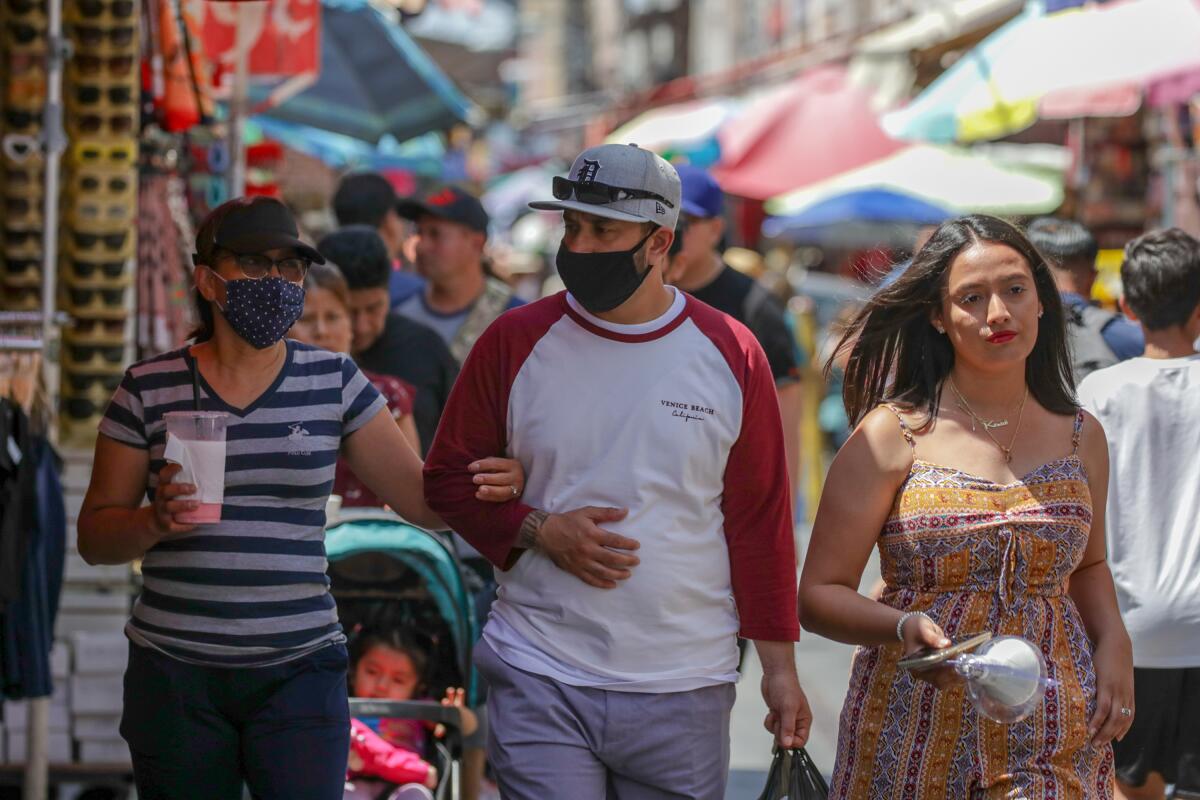
This attitude is not unique to California or the West. The Pew Research Center’s most recent survey about Americans’ attitudes about the pandemic found that only 41% considered the coronavirus “a major threat to public health.” That’s the lowest figure Pew has ever recorded. (An additional 45% considered the virus a “minor threat” and 13% called it “not a threat.”)
Likewise, only 34% of respondents were either “somewhat” or “very” concerned that the virus would land them in the hospital, and 50% were “somewhat” or “very” concerned that they’d spread an infection to someone else. Those figures also represent all-time lows for the pandemic.
Nationwide, daily COVID-19 deaths have averaged around 365 over the last week. The count hasn’t been that low for a year, since the lull before the Delta surge. The only other time it has been lower was the initial weeks of the outbreak. So perhaps there is less reason to fear the coronavirus.
“If your metric is infections, it looks hopeless,” Chin-Hong said. “But if your metric is people getting seriously ill and dying — wow, that’s a huge victory.”
For the most part, the public is focused on the latter metric. But the health establishment is mostly focused on the former, especially the speed with which new variants are emerging and the possibility that one of them will be impervious to our vaccines and treatments, effectively sending us back to square one.
That helps explain why Los Angeles County is probably on the verge of reinstating an indoor mask mandate. Unless conditions substantially improve in the next couple of days, the county is likely to learn Thursday that it is entering its third consecutive week with a “high” COVID-19 community level because it has more 200 new infections and more than 10 new COVID-19 hospital admissions per 100,000 people over the last seven days. (As of last Thursday, there were 481 new infections and 11.4 new hospital admissions per 100,000 people per week.)
Bringing those numbers down is necessary to protect the vulnerable among us, such as the elderly and people who are immunocompromised, said Dr. Robert Kim-Farley, an epidemiologist and infectious diseases expert at UCLA.
“What we need to do is have a mindset, or social norm, that we are going to expect somewhat of a roller-coaster ride as new variants arise and sweep through the population,” he said. “We can go back to more business as usual, but when rates are high, we should all do our part in reducing transmission.”
Julisa Carrillo hopes people hear that message. She was hospitalized because of COVID-19 twice before the vaccines became available. Both of those hospitalizations included time on a ventilator.
More than a year and a half later, her lungs still don’t feel the same. In her view, wearing a mask feels like a reasonable trade-off to help people avoid that same fate.
“This is a virus that is hurting so many people,” she said as she waited for a bus in Huntington Park. “I myself don’t feel safe.”
By the numbers
California cases and deaths as of 6:30 p.m. Tuesday:

Track California’s coronavirus spread and vaccination efforts — including the latest numbers and how they break down — with our graphics.
Biden and our pandemic progress
The coronavirus can come for anyone, even the leader of the free world. Then-President Trump’s illness in 2020 may have seemed like a bit of bad luck — though if we’re being honest, his White House wasn’t being particularly careful — but current President Biden’s diagnosis confirms that even those who take abundant precautions are vulnerable.
But it’s not all bad news for Biden. Catching the coronavirus in the summer of 2022 is not at all like catching it in the fall of 2020, my colleague Melissa Healy reports. Unlike Trump, Biden is benefiting from a full 2½ years of scientific and medical advances against the once-novel virus. Plus, the virus itself has changed in ways that make it harder to evade but easier to survive.
Biden said Monday that he’s “feeling better every day.” His schedule is lighter than it would have been while he’s isolating at the White House, “but I’m meeting all my requirements that have come before me,” he said.
Here’s a look at the many advantages for Biden — and the roughly 850,000 other Americans who caught the virus in the last week — that weren’t available to Trump:
VACCINES: When Trump was diagnosed in early October 2020, the first COVID-19 vaccine from Pfizer and BioNTech was more than two months away from being authorized for emergency use by the Food and Drug Administration.
By the time Biden was diagnosed, he had received two primary doses of the companies’ Comirnaty vaccine, plus two booster doses. His most recent shot was on March 30. A letter from Dr. Kevin C. O’Connor, the White House physician, described him as “maximally protected.”
“I’m doing well, getting a lot of work done,” he said in a video. (He’s following Dr. Anthony Fauci’s lead and trying to power through instead of taking the time to rest and recover.)
Biden himself credited his four shots for his “mild” illness. His symptoms included a runny nose, cough, sore throat and some body aches.
Data from the Centers for Disease Control and Prevention back him up. Among Americans 65 and older, those who are unvaccinated are 3.8 times more likely to wind up hospitalized with COVID-19 than those who have been vaccinated and boosted at least once.
What’s more, people in Biden’s age group — 65 to 79 — who are unvaccinated are nearly 9 times more likely to die of COVID-19 than their counterparts who are vaccinated and boosted. The second booster is important: The risk of death for Americans 50 and older who received it was four times lower than for their peers who stopped at one booster.
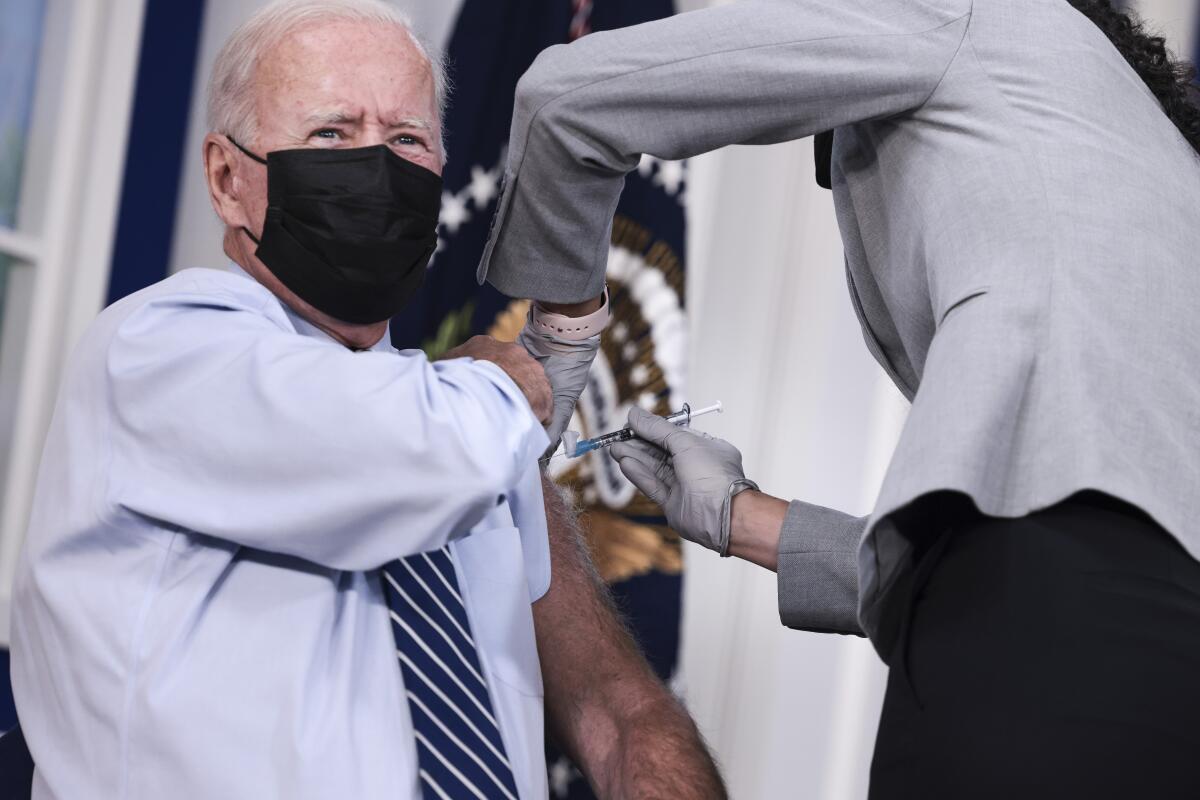
TREATMENTS: By the time Biden’s illness was announced, he had already begun a course of Paxlovid. In clinical trials, patients at high risk of becoming severely ill were 88% less likely to be hospitalized or die if they took the antiviral (which is administered in pill form over five days). Biden falls into the “high risk” category because of his age (he’ll turn 80 in November).
Paxlovid received emergency use authorization in December, more than a year after Trump’s bout with COVID-19. After initial shortages, it is now available at “test to treat” sites around the country, and as of this month, pharmacists have clearance to prescribe it to patients.
Should Biden take a turn for the worse and develop symptoms such as low oxygen levels, blood clots or problems with his heart or kidney function, there are plenty of other tools available to his doctors.
Remdesivir, which was given to Trump, would be available as a backstop, said Dr. Roy M. Gulick, who co-chaired the National Institutes of Health’s panel on COVID-19 treatment guidelines. Today, physicians could also turn to one or more of the specialized drugs that calm an overactive immune system; although these were developed to treat other diseases, they’ve been found to help those with COVID-19 as well.
Doctors have refined a variety of treatments while tending to America’s 90-million-plus patients over the course of the pandemic, Gulick said. For instance, they’re quicker to prescribe blood thinners for hospitalized patients to reduce the risk of blood clots. They’ve streamlined their use of steroids. They’re more cautious about putting patients with breathing difficulties on ventilators, since they have the potential to do more harm than good. They’ve also figured out how to position patients with obesity to help keep their airways clear.
“So much has changed since Trump got COVID,” Gulick said. “We have made substantive progress in treating people with severe COVID who are admitted to hospital,” and fewer are dying as a result.
THE VIRUS ITSELF: We may lament the seemingly endless parade of variants and subvariants. But if you had to be infected with the SARS-CoV-2 coronavirus, you’d rather have a version of Omicron than the original strain from Wuhan, China.
Trump fell ill before the emergence of the Alpha variant in the U.K., so it’s a safe bet that he was sickened by a virus that closely resembled the one that left China in late 2019. Virtually all of the SARS-CoV-2 coronaviruses circulating in the U.S. today are some version of Omicron, with the BA.5 subvariant alone accounting for an estimated 82% of specimens, according the CDC, and O’Connor said that’s probably the strain that got Biden.
For most of the pandemic, the COVID-19 death rate among those infected stood at about 2% of reported cases. But that figure dropped significantly after Omicron arrived, according to Beth Blauer, an associate vice provost at Johns Hopkins University. Now, fewer than 0.5% of reported infections results in death.
Population immunity from vaccines and past infections may help explain that progress, she wrote, but “the data trends clearly demonstrate that Omicron is a much less deadly variant.”
California’s vaccination progress
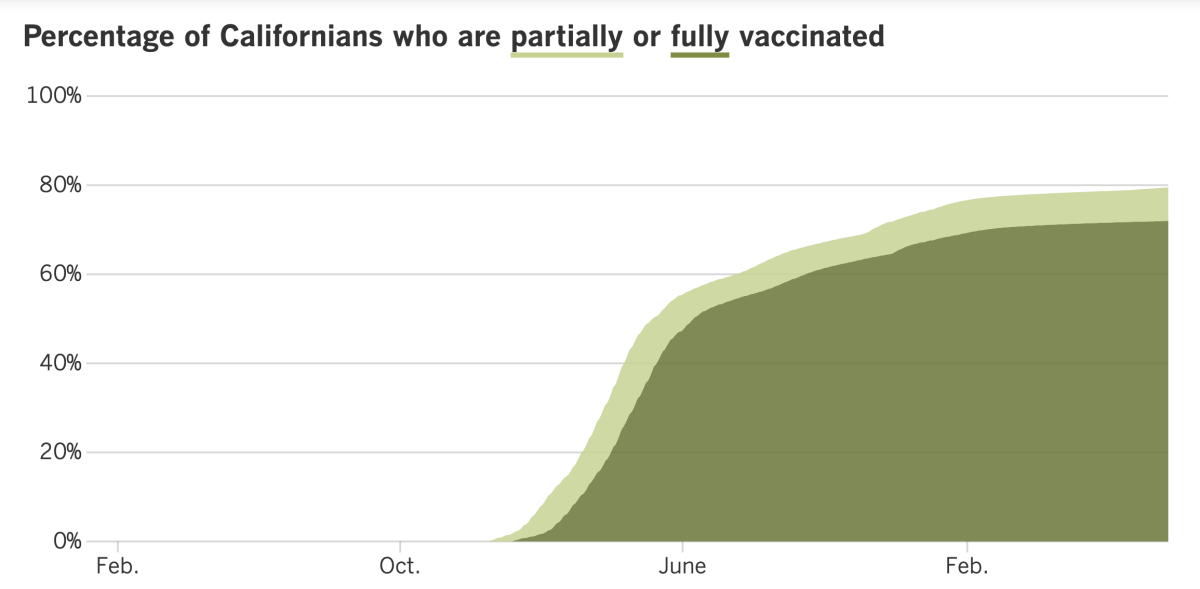
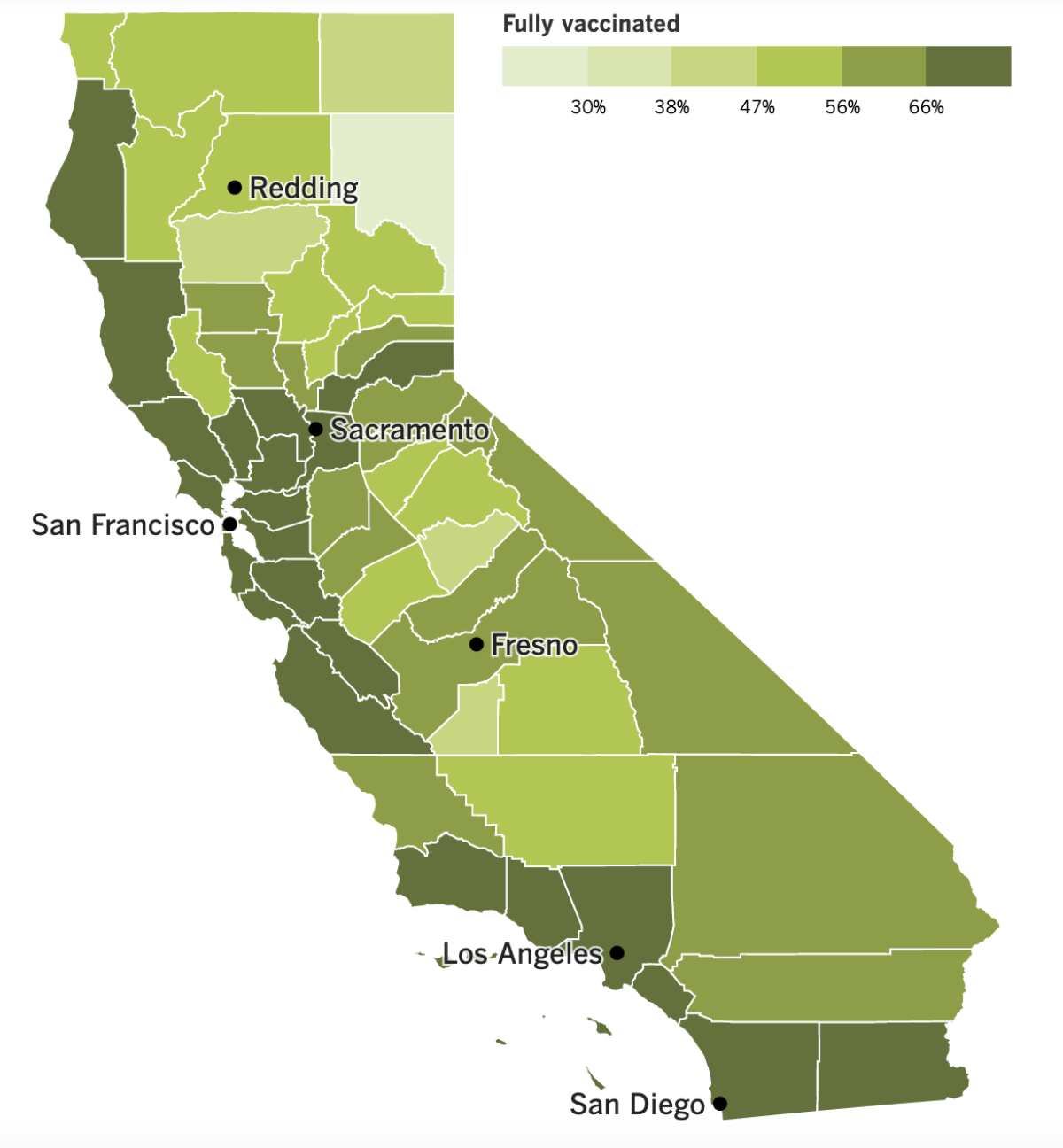
See the latest on California’s vaccination progress with our tracker.
Your support helps us deliver the news that matters most.
In other news ...
Through parts of June, Los Angeles County and the San Francisco Bay Area had similar COVID-19 mortality rates. Then July came along, and deaths rose in L.A. — but that increase was not matched up north.
As of Monday, the Bay Area had 56 deaths per 10 million residents over the last week. L.A. County, meanwhile, recorded 96 deaths per 10 million residents in the same period, a figure that was 70% higher.
It’s not clear why deaths went up here but not there. L.A. has a higher poverty rate and more overcrowded housing. That means if one member of a household is infected, the number of people at risk of exposure is greater. Vaccination rates are also lower here than they are up north. According to The Times’ tracker, 73.7% of L.A. County residents are fully vaccinated; that percentage is lower than in all but one Bay Area county (Solano).
There are hints that L.A.’s death toll may begin to fall soon. The official count of new infections here has begun to decline, as has the number of infected patients in the county’s hospitals. Last Wednesday, that number stood at 1,329; by Friday, it was down to 1,200, before rising somewhat to 1,286 on Monday.
As for coronavirus cases, the county was averaging about 6,100 infections per day over the week that ended Monday. During the previous week, the average number of daily infections was nearly 6,900.
Those improved trend lines are fueling hope that L.A. County Public Health Director Barbara Ferrer might not implement an indoor mask mandate later this week even if the county still has a “high” COVID-19 community level.
“Should we see sustained decreases in cases, or the rate of hospital admissions moves closer to the threshold for medium, we will pause implementation of universal indoor masking as we closely monitor our transmission rates,” Ferrer said. No decision will be made until after the CDC updates its community-level assessments on Thursday.
Officials in Beverly Hills would be happy to see the county demur on a mask mandate. The City Council voted unanimously Monday night not to enforce an indoor mask rule, should one materialize.
“I support the power of choice,” Mayor Lili Bosse said in a statement. “This is a united City Council and community that cares about health. We are not where we were in 2020, and now we need to move forward as a community and be part of the solution.”
Restaurants and bars, on the other hand, are already bracing for the stink eye they expect to get from customers if they have to go back to enforcing an indoor mask mandate. The job will be even more difficult this time around because the BA.5 subvariant has forced eating and drinking establishments to operate with skeletal staffing.
“I’m fearful and I’m nervous and there’s a lot of anxiety behind it,” said Robert Fleming, who opened the Capri Club bar in Eagle Rock in June.
Plenty of other employers are dealing with COVID-induced staffing shortages too. Notable among them is the Transportation Security Administration.
The L.A. County health department says at least 233 cases have been confirmed among TSA workers at Los Angeles International Airport since June 9. The federal agency acknowledged an outbreak at LAX but said the figures released by the county overstated the current state of infections.
President Biden wasn’t the only politico to catch the coronavirus in the last week. Democratic Sen. Joe Manchin III of West Virginia tweeted Monday that he tested positive for an infection and was experiencing mild COVID-19 symptoms. His Republican colleague Sen. Lisa Murkowski of Alaska tweeted similar news Monday and said she was experiencing flu symptoms.
On the research front, a study from USC has identified some new potential risk factors for developing long COVID. Like previous studies, the analysis found that patients who had obesity prior to their illnesses were more likely to have the lingering symptoms associated with long COVID. The USC team also found that patients who had sore throats, headaches and hair loss after becoming infected with the coronavirus were more likely to have long COVID.
The researchers don’t think hair loss itself causes long COVID. Rather, they suspect that hair loss “reflects extreme stress, potentially a reaction to a high fever or medications,” said Eileen Crimmins, a demographer at USC’s Leonard Davis School of Gerontology who worked on the study that appeared in Scientific Reports. “So it’s probably some indication of how severe the illness was.”
Separately, a pair of studies by an international team of experts used different analytical approaches to home in on the epicenter of the pandemic that has killed more than 6.4 million people around the world. Both methods point to the same conclusion: The coronavirus probably jumped from animals to humans at the Huanan Wholesale Seafood Market in Wuhan, China. In fact, it probably happened at least twice.
Several researchers who worked on the new papers had been open to the possibility that the virus had escaped from a Wuhan lab. But sleuthing over the last year or so has convinced them that the market is a far more plausible culprit.
“In a city covering more than 3,000 square miles, the area with the highest probability of containing the home of someone who had one of the earliest COVID-19 cases in the world was an area of a few city blocks, with the Huanan market smack dab inside it,” said one of those researchers, University of Arizona virologist Michael Worobey.
And finally, it looks as though there are no countries left that have more than 100,000 people but are still coronavirus-free. The island nation of Micronesia (population 115,000) appears to have been the last to fall — and its outbreak is a doozy. It began last week and has already spread to at least 1,261 people. Eight people have been hospitalized with COVID-19, and one has died.
Turkmenistan is now the only remaining country with a population of at least 100,000 and no official coronavirus cases. Outside experts believe, however, that the virus is there and the country’s autocratic leaders are simply ignoring it.
Your questions answered
Today’s question comes from readers who want to know: Should I let the county health department know that I got a positive result on a rapid test?
If you live in L.A. County, you don’t have to.
That said, there are some calls you should make. If you have a regular healthcare provider, let them know that you’ve tested positive.
You should also inform your recent close contacts so they can be tested. A close contact is someone who’s been within 6 feet of you for a total of 15 minutes over a 24-hour period. Anyone who fits that bill in the two days leading up to your first COVID-19 symptoms or your positive test result (whichever came first) deserves to hear from you.
If you need help tracking down your close contacts, you actually do have a good reason to call the L.A. County Department of Public Health. The department has set up a hotline to assist residents with issues like these. The folks there can also answer questions you may have and can help you get a prescription for an antiviral medication, if warranted. The number for the hotline is (833) 540-0473.
The county health department is keeping track of the positive home test results they hear about. But a spokeswoman told my colleagues Jon Healey and Karen Garcia that department officials don’t need you to tell them that you’ve tested positive — and they definitely don’t want you to tell them if you’ve tested negative.
It’s not just that health officials are too busy to take your call. It’s that they can’t gauge the reliability of the home test you (and everyone else) used, or whether you (and everyone else) used it correctly. That’s why they tally only the results of tests performed in a laboratory.
L.A. County is hardly alone in this regard — even the CDC takes this approach.
We want to hear from you. Email us your coronavirus questions, and we’ll do our best to answer them. Wondering if your question’s already been answered? Check out our archive here.
The pandemic in pictures
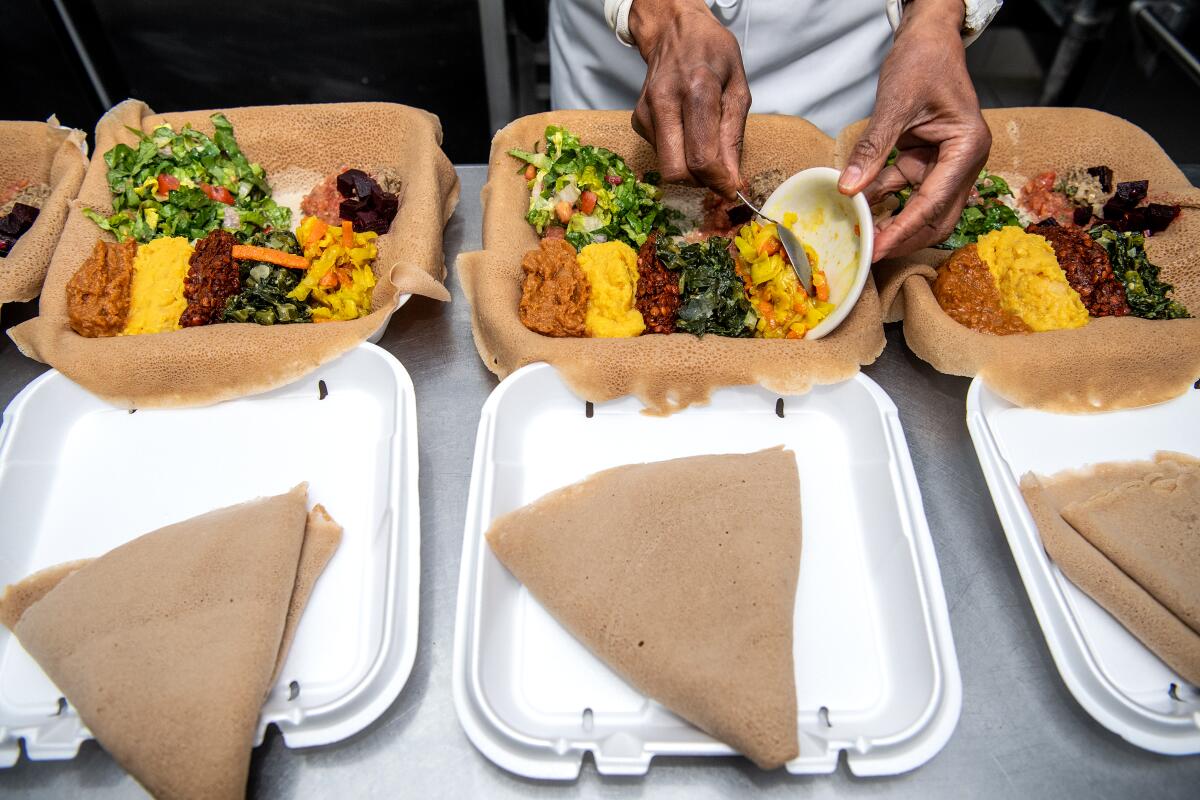
The hands in the photo above belong to chef Genet Agonafer. She’s the proprietor of Meals by Genet, the bistro in L.A.’s Little Ethiopia that helped make the berbere-centered flavors of her native country “one of the important pieces of the mosaic that defines Los Angeles cuisine,” as my colleague Laurie Ochoa writes.
Ochoa selected Agonafer as The Times’ 2022 Gold Award honoree. The award is bestowed not just for excellent cooking but also for broadening our culinary horizons.
In light of this praise, you might expect Meals by Genet to have a packed dining room. But when restaurants were able to reopen their dining rooms, Agonafer decided to keep hers closed. (She makes occasional exceptions for weddings and other private parties.) She hadn’t missed the stress of full-on restaurant work, but she didn’t want to close down altogether. So she opted for a compromise, offering takeout dinners on Thursdays through Sundays.
Although the limited hours mean less money, Agonafer said it’s a worthy trade-off.
“Everything is just peaceful and easygoing,” she said. “There is still that stress when the rush happens or when we have events here, but things are going so incredibly well.”
Resources
Need a vaccine? Here’s where to go: City of Los Angeles | Los Angeles County | Kern County | Orange County | Riverside County | San Bernardino County | San Diego County | San Luis Obispo County | Santa Barbara County | Ventura County
Practice social distancing using these tips, and wear a mask or two.
Watch for symptoms such as fever, cough, shortness of breath, chills, shaking with chills, muscle pain, headache, sore throat and loss of taste or smell. Here’s what to look for and when.
Need to get a test? Testing in California is free, and you can find a site online or call (833) 422-4255.
Americans are hurting in various ways. We have advice for helping kids cope, as well as resources for people experiencing domestic abuse.
We’ve answered hundreds of readers’ questions. Explore them in our archive here.
For our most up-to-date coverage, visit our homepage and our Health section, get our breaking news alerts, and follow us on Twitter and Instagram.




